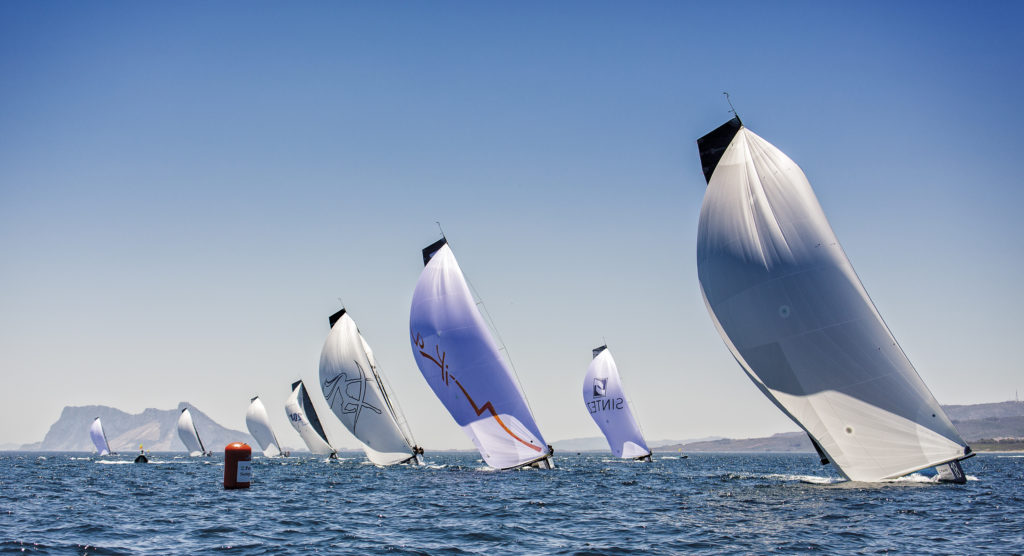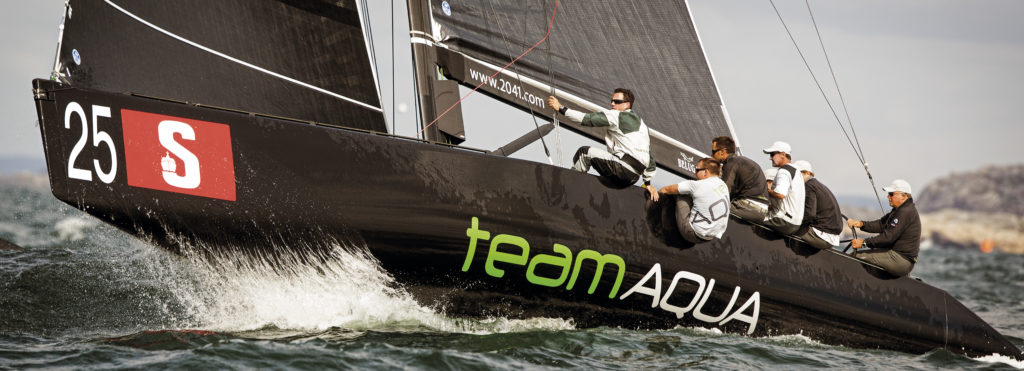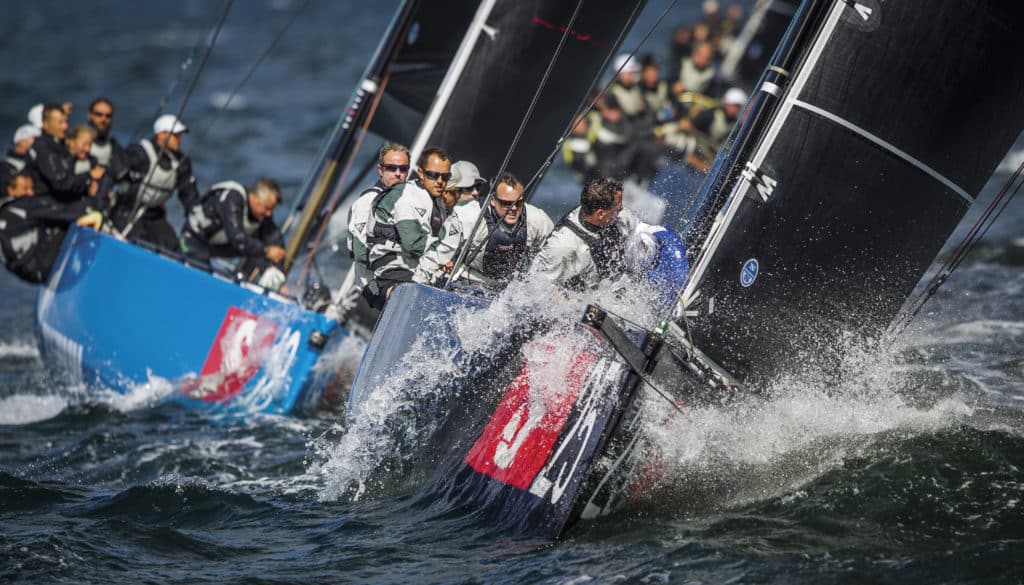
The RC44 class celebrated its 10th anniversary in 2016, and with 11 boats regularly competing on a circuit straddling Europe and the Caribbean, the high performance owner-driver keelboat continues to prove itself as an enduring contemporary one-design race boat.
The RC44 is of course unique among one-designs in having been conceived by ‘the man’ himself, America’s Cup legend Russell Coutts, along with Slovenian designer, Andrej Justin. While Coutts is known for his prodigious sailing talent, part of his success is due to his formal training as an engineer and his deep understanding of the technical nuances of race boats. As one might expect from Coutts, the RC44 is an uncompromised, state of the art production boats that is in no way dumbed down.
While it is light, with a slender hull form, the RC44 keel draws 2.9m with a CNC-machined bulb that ensures the keel’s center of gravity is as low as possible. It is also the only one-design to feature a trim tab on its keel – a standard feature on Version 5 America’s Cup monohulls. This provides lift, dramatically improving the keel’s efficiency upwind, also allowing the foil to have a smaller, lower drag section. This is just one of several features of the RC44, showing the boat’s America’s Cup pedigree.
“We’ve had a lot of great moments sailing the boats,” says Coutts. “They’re fun to sail and the builders did a nice job of making sure they’re equal. The class rules are well administered, so it means that the racing is close and you see different winners at different events, which keeps it interesting and exciting for the teams competing.”
Managed from Switzerland by Bertrand Favre, who also runs the D35 catamaran circuit on Lake Geneva, the RC44 Class has always attempted to lead the way in race management. It was among the first to adopt on-the-water umpiring, thereby negating tedious post-race protest hearings. From the outset, the class has maintained top level, consistent race management with Peter Reggio the RC44 Championship’s regular PRO and Marco Mercuriali its Chief Umpire. It has also responded to the call of its owner-drivers, who determine the class’ direction, to reduce course lengths. This enables 10 to 14 races over each event’s four days of fleet racing, maximizing owners’ ‘bang for their buck.’
One area where significant thought went into in the design of the RC44 was its transportation. With circuits regularly visiting different corners of the globe, shipping a yacht as deck cargo represents a significant percentage of annual running costs, as well as increasing the risk of damage.
Therefore, from the outset, the RC44 was designed to fit into a standard 40-foot flat rack container. Shipping this way costs around one third to a quarter the price of going deck cargo. To achieve this, the boat has a removable transom scoop, while the mast is two-piece.
“This makes the boat manageable in terms of transportation and it means we can pack them away and store them safely, easily and cost-effectively,” says Coutts. “It also allows the class to go to all sorts of different venues around the world. The owners enjoy being able to race in different places each year.” For example, in 2016 the RC44 Championship visited Bermuda and Portsmouth, UK for the first time.
The detachable bow and stern also makes for easy repair or replacement of these vulnerable parts. “If you do have an accident or a collision it’s simple to repair the boat and get sailing the next day,” says Coutts.

The most ingenious aspect of the RC44’s “containerisation” is how it allows the boat to be assembled and disassembled without the need for a crane or a forklift truck. Four vertical beams plug into the flat rack and, using these, the hull can be elevated by 4m. The keel fin is then dropped onto the bulb and the hull fitted on to the fin. There is no need for any fairing or finishing. Key to this is the construction of the foil, which is entirely carbon fiber, rather than the more normal steel strut with a carbon/steel fairing. As a result, it weighs just 120kg, so lifting it into position is a three man job. Typically, assembling an RC44 takes two days; breakdown, one day.
Over the last decade, the RC44 has been continually upgraded. Most recently, the entire B&G electronics were replaced with latest generation H5000. Before that, the mainsails were redesigned with a new, enlarged square top and similarly the J3 sheet fairlead system has been modified to have up-down and lateral adjustment, and a jib Cunningham and a new checkstay adjustment system added. Modifications are carried out on all boats simultaneously, keeping them identical while allowing new equipment to be bought cost-effectively in bulk.
Aside from the boat’s technical side, Coutts says the level of competition has improved greatly. “They are being sailed a lot better now than they were ten years ago. The crews have learned how to sail them and develop the sails and the techniques of sailing them.”
Among the RC44s, the USA matches Italy with three tacticians spread across the fleet, and in a fine display of this post-Cold War era, two sail with Russian owners – Ed Baird on Vladimir Prosikhin’s Team Nika while Andy Horton is on Alexander Novoselov’s Katusha. The third, Chris Larson, sails with Dutchman Nico Poons’ Charisma.
Andy Horton is a big fan of the RC44:.“The cool thing about this boat is that there is no faster 40 footer,” he says. “There are some other boats which have tried to do over the years what this boat has done. This blows the Farr 40 out of the water both upwind and downwind. We have the big genoa, so we can sail in 6 knots of breeze and if it’s 20-25 knots we can still go and rip around and do 20-25 knots downwind.
“The narrowness of it and the trim tab let you point upwind — some of the wider boats just won’t do that and the foils are more efficient downwind. As a team, everyone does something, they all have jobs, with eight guys on a boat this size with backstays, a canting pole, the trim tab, et cetera — there’s a lot of action and that’s what’s fun about this. I get to touch a sheet, which never normally happens.”
For an owner, Horton says the RC44 is also attractive. It has a comfortable position to steer from with twin wheels, but this doesn’t make it a cruising boat. It is even a good class on which to learn. “Two and half years ago I used to sail this with someone who had never sailed a boat before,” says Horton. “Two regattas later, he won his first race and this year he was third on the podium. So it is teachable. The boat is powerful and is always heeled, so you can drive to that. But the racing is still awesome, right at the top end.”
With the America’s Cup gone multihull, there are still a lot of top-level monohull crew available to compete in classes like the RC44 and TP52. In fact many interchange, such as Ed Baird, who also skippers the Quantum Racing TP52, while Italy’s Vasco Vascotto calls tactics on Peninsula Petroleum, as he does on the Azzurra TP52.

Being a smaller one design with less crew and simplified logistics means that the RC44’s running costs and complexity of campaigning are minimised compared with larger classes. A new RC44 costs around 450,000 Euros, while a good second-hand boat is 250,000 (all up, including boat flat rack container plus a 20ft workshop and equipment storage container for sails, and spares.) This compares to 2 million Euros for a new TP52 and around half that for a good second-hand boat, excluding 400,000 Euros more for a container/workshop and support boat.
Running costs, typically range from 450,000 to 700,000 Euros per year. With the RC44, the running costs for the boat are similar between teams. For example, sail buttons are limited to six per year with an extra one permitted for teams completing a whole season. Thus an annual sail budget is around 120,000 Euros. New teams joining the RC44 Championship are permitted eight sail buttons. Beyond this are salaries for crew and shore crew, typically a minimum of two, and extras such as coaching. For 2017, running costs are expected to drop by 20-25% due to the shorter duration of regattas — the match racing is being dropped and regattas will solely comprise four days of fleet racing.
“It is the only boat where the running costs are more than the capital cost,” says Horton. “Not because the running costs are expensive, but because the capital costs are so inexpensive. And the class is run efficiently. Instead of having to rent ten cranes for the fleet there is one and there are few headaches because the class handles all the transportation and shipping.”
The RC44 class has been keen to ensure that their events are family-friendly, so at every regatta there is a VIP entertainment area as well as a boat from which friends, family and sponsors can watch the racing. There is also a guest program, thus, when conditions allow, it is possible for guests to experience the thrill of competing on a RC44 first hand.
With several long-term owners in the class, great friendships have been formed. Inadvertently, the class has developed a reputation for attracting several of its owner-drivers from the oil and energy commodities businesses such as Torbjörn Törnqvist (Gunvor), Chris Bake (Vitol) and John Bassadone (Peninsula Petroleum). “That’s been a good dynamic to have,” says Coutts. “The racing’s competitive, but the owners and the teams enjoy themselves off the water as well.”
In recent years Coutts has been focussing on flying catamaran racing, so has the sport split in two now? “It has, but the same guys win whatever the format, whether it’s foiling catamarans, high performance monohulls or heavy displacement monohulls: It’s still sailing,” he says. “Ben Ainslie could get into any of those boats and still win. Sure, they perform differently and strategies are slightly different, but it still requires the same fundamental skills. The best sailors can adapt and still win whatever the format.”
As to the RC44, he’s proud that the boat that bears his name is celebrating its 10th anniversary. “The boat has been regularly upgraded and it has such a fine group of loyal owners,” says Coutts. “I see no reason why the RC44 won’t continue to be just as strong for many years to come.”









